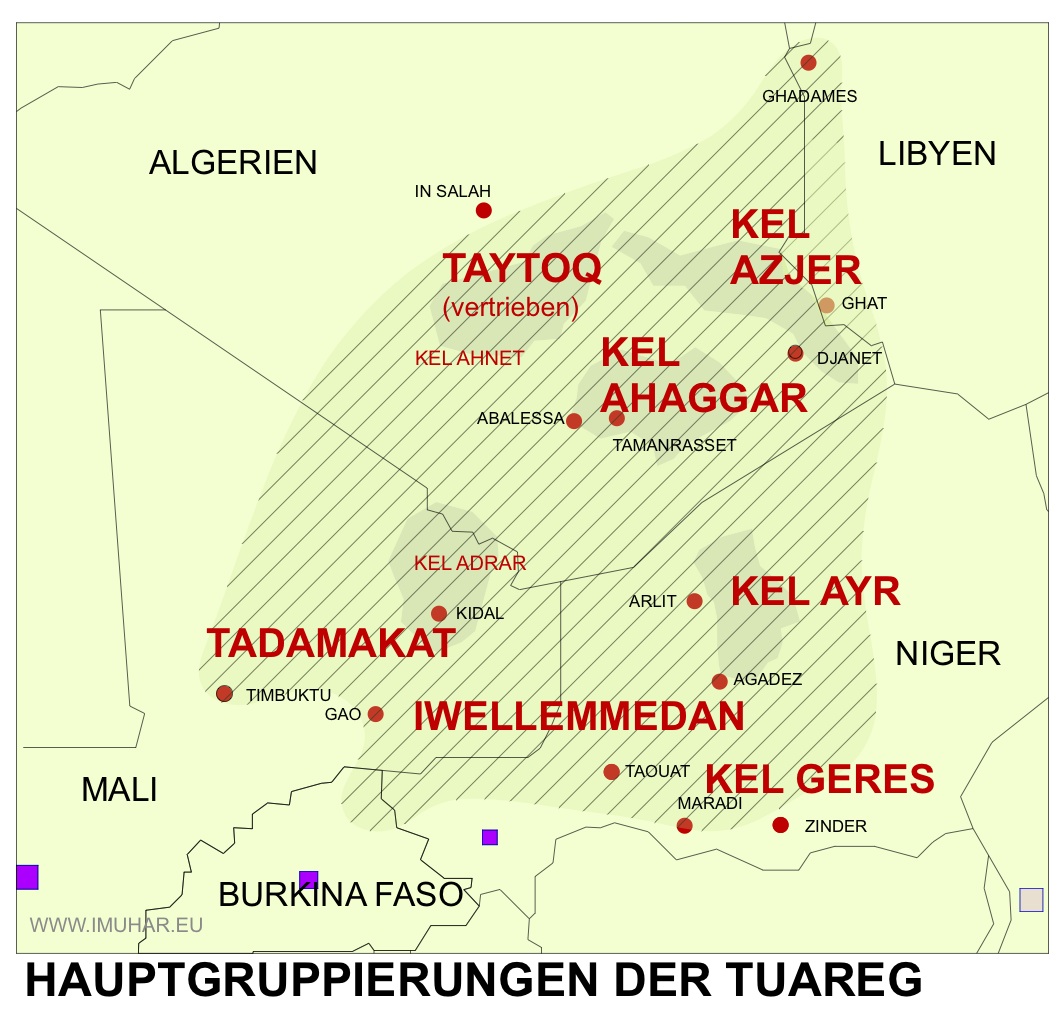THE IMUHAR ("TUAREG") PEOPLE
AN INTRODUCTION TO THE IMUHAR ("TUAREG") SOCIETY WITH MAPS AND STATISTICS
The Tuareg are a non-state Muslim society of more than 1.5 million people. They live in an area that stretches across 2 million square kilometers in the African Sahara and the Sahel, predominantly in Southern Algeria, Northern Niger, Northern Mali, Southern Libya and Northern Burkina Faso. Imuhar ( and not Tuareg) is the correct name of the society in the Central Sahara desert. Scroll down for relevant statistics and maps.
.jpg)
TERRITORY
The Tuareg people live in an extremely dry (arid) desert area in the Sahara and in the West African Sahel. Nowadays most of the "Tuareg" people live in the Sahel area of Mali and Niger.
NOMADS
Most of the Tuareg nomads live in the Sahel of Mali and Niger as well. Some groups of nomads live in the Sahara of Algeria.
IMUHAR NOMADS
On this webpage the nomads in southern Algeria are mainly presented. They call themselves Imuhar.
Tents
Clothing / Fashion / Hairstyle
Jewelry
Nutrition
Belief / Religion / Ghosts
Work and more
IMUHAR / TUAREG
The term Tuareg (Twareg / Touareg) is not used by the people themselves; it is an outside label. The origin of the term is subject to much speculation. The proper name, i.e., the one used by the nomads themselves, is Imuhar (in Algeria/ Libya), Imushar (in Mali/Burkina Faso) and Imasheren (in Niger).
General Designations
Etymology TUAREG
Etymology IMUHAR


Map of self designation of the "Tuareg" Map of the "Tuareg" - main groups
HISTORY
The Tuareg society formed of several groups of Imaziren (Berber), which penetrated from the 9th century from North Africa in the Sahara and established goat breeders. The nomads bred goats and camels. They controlled the transit trade through the Sahara until the French military penetrated into their territory at the beginning of the 20th century. Colonial powers divided the territory of the Tuareg people, from which arose the present-day states.
Origin
History 1 / Settlement
History 2/ Colonial Era
History 3/ National State
THE TUAREG MYTH
The recorded history of the Tuareg is a product of French colonists and European travelers. Based on an eurocentric view, the Tuareg society was reported to consist of proud knights, nobility, vassals and permissive women.
MYTH: Noble and their vassals
MYTH: Garamantes as ancastors
TRADITIONAL SOCIETY
The classical system of society is divided into seven regional main groups. The main groups are composed of multiple subgroups. Within a subgroup, there are the social groups (communities) of nomads, craftsmen, religious people, agricultural workers and slaves.
Social System
Ihaggaren / Kel Ulli (Noble/Vassals)
Political System
Generations
CURRENT SITUATION
Nowadays the Tuareg society is a marginalized minority in several countries. Since the individual nation-states developed separately, the socio-cultural ways of life of the regional "Tuareg" groups developed differently.
While during the French colonial period large area in the Northwest of Tamarasset (southern Algeria) were contaminated by atomic bomb tests, now vast areas around Arlit (Nord Niger) are contaminated by above-ground mining of uranium.
Repeatedly violent rebellions by "Tuareg" men were waged against the governments of Mali and Niger. Not only because of the rebellions the lucrative Sahara tourism currently is brought at a standstill. The outbreak of violent conflicts in northern Mali in 2012 led to displacment of more than 200.000 Tuareg to surrounding countries.
UNHCR Tuareg refugee camp Goudebou in nothern Burkina Faso
about 38.000 refugees in Burkina Faso/ October 2016
Nowadays the Tuareg people in the urban environment are faced with low living standards, extensive corruption and high unemployment. Although nomadic lifestyles are endangered in some parts of the world, the Imuhar nomads remain a vital group of nomads.
Postnomads
Music of the Rebellion

PARTICULAR TOPICS
MUSIC
The music is a well-known cultural heritage of the Tuareg society. While earlier there are mainly female music performers, the new guitar music is dominated by men.
Classical Music and Poetry
New Music
New Tuareg Music Groups
New Tuareg Music Concerts
ART OF SPEAKING
The language of the people is called Tamasheq (in Mali/Burkina Faso/Niger) or Tamahaq (in Algeria/Libya) and the script is called Tifinar.
Map of the territory of the "Tuareg" society
| Self-designation |
Name of the Language
|
Area |
Main Groups (Selection) |
Population * (approximate numbers) |
| Imuhar |
Tamahaq (Tahaggart) Tamahaq (Tazjert) Tamahaq (Tahnet) |
Algeria (Ahaggar) Libya (Ghat) Algeria (Ahnet) |
Kel Ahaggar Kel Ahnet (former Taytoq) |
Algeria,Libya 62.000 (1987) |
| Imushar |
Tamasheq (Tadrart) Tamasheq (Tademekkat) |
Mali (Kidal), Burkina Faso (Udalan) Mali (Timbiktut, Gao) |
Kel Adrar Udalan Tademekkat |
Mali, Burkina Faso 190.000 (1991) |
| Imasheren |
Tamasheq (Taïart)
Tamasheq |
Niger (North,
Niger (South) |
Kel Ewey
Kel Geres |
Niger 640.000 (1998) Kel Ewey 18.000 (1989;Spittler) with Agadezregion250.000 (1998) |
|
|
*Note: No accurate statistics exists, and not every “Tuareg” has an identity card. The population figures quoted here are taken mostly from Ethnologue (http://www.ethnologue.com / state in 2009) and should be considered very approximate numbers, as no accurate statistics exists.
